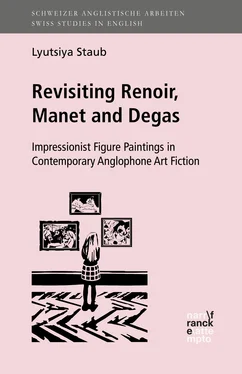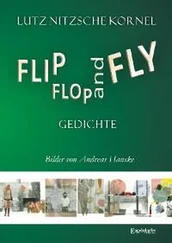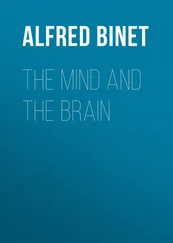Chapter Two lays out the theoretical dimensions of the research, addressing the question of the visual and the verbal and emphasising the complementary function of arts. It examines the idea that the semiotic duality of an intermedial artefact facilitates close interaction between spatiality and temporality and by doing so creates great potential for generating new meanings in a cultural product, thus leading to new interpretations. There are different ways of manifesting visual arts within a literary text; however, the present analysis focuses solely on the actual subject matter captured directly in both media, bringing ekphrasis and the variety of ekphrastic relationships into the primary focus in contemporary art fiction. The first section presents a brief diachronic overview of the evolution of the definition of ekphrasis (Webb, Lessing, Heffernan, Krieger, Mitchell, Cheeke, Clüver, Yacobi). The study suggests a contemporary reading of the phenomenon of ekphrasis based on the tripartite principle of the representation of an art object and its multiple re-interpretations and proposes to define ekphrasis as a verbal re-presentation and re-interpretation of a visual representation (painting). The chapter moves on to consider the diversity of ekphrastic relationships by introducing several typologies of word-image relations (Hollander, Heffernan, Yacobi, Torgovnick, Robillard, Sager Eidt). I adapt and challenge the existing categories of ekphrasis by making them more specific for my study and finally elaborate a framework of intermedial interaction ( communicative , re-presentational and interpretative categories) that is further applied to the study of selected contemporary art fiction narratives. While the communicative category is concerned with paratexts of contemporary art fiction, the re-presentational category focuses on ekphrastic descriptions of details, composition and the process of creation of an artwork, and the interpretive category considers perception and interpretation of a painting as well as meta-commentary on art movements in general provided by the story’s actants. In the chapters that follow I will examine different types of ekphrasis as well as their combinations in the novels in order to analyse to what extent the visual source is used in the text, which aspects of it are highlighted, which are omitted altogether, what is added and why. The overall objective of this research is to examine if and how art fiction influences the way the painting is perceived and to determine what effects the transmission of a painting through one or several ekphrastic categories ( communicative , re-presentational or interpretative ) has on its general understanding.
Chapter Three concentrates on the communicative category and analyses how the co-presence of media is established in the paratextual zone (Genette) of contemporary art fiction, with main focus being on the verbal and visual elements of the book cover. This chapter promotes the approach of judging the book by its cover. As the first manifestation of an intermedial artefact the book cover frames the future reading of the text. It provides the reader with verbal (the name of the author, title, genre indication, press blurbs) and visual (cover illustrations) information that aims to attract attention to the product, establish a relationship with a potential reader, encouraging the reader to interpret the conveyed meaning of the literary work in question, and eventually to persuade the reader to purchase the book. In this chapter, it will be argued that in the case of art fiction based on extant works of art, the book cover becomes a manifestation of the intermedial nature of the product (referring to the content of the book, naming or illustrating the characters, or alluding to the artist, an artwork or an artistic movement in general), often giving the reader an opportunity to engage with an art object both visually and verbally and thus activating new reading skills. I will analyse the form in which the textual and iconic images appear, the location of the image and the text, their referents and their inter-relationship on the front and back covers. The main purpose of this research is therefore to study the role of the book covers of art fiction, to interpret the functions of displayed verbal and visual elements and, most importantly, to examine the effects they produce.
The fourth chapter focuses on the re-presentation of visual sources in art fiction. Contemporary writers tend to take the reader on a journey around the painting and show it gradually coming to life. That is why in this section I examine how the artwork is re-presented through the process of its making – considering the labour that goes into a creation (obtaining inspiration, finding locations and models, choosing colours, applying paints, confirming composition, considering details, dealing with the problems of artistic creation and the like). I will argue that by narrating the process of making, the novelists – delving deeper into the images and their stories – on the one hand accentuate the dynamic and experimental activity of art making and draw attention to the fact that artworks are neither really static nor unchanging, while on the other, by examining the artist’s intentions in the process of creating an artwork, suggest a new narrative interpretation of the image.
As the central element of a figure painting is a human model, the process of making an artwork naturally involves posing. During the modelling process, the reader is introduced to the model as an element of a painting. However, in art fiction models also have the ability to move within and beyond a given artwork, live and act on and off the canvas, interact directly with the creator (thus becoming a mediator between the creator and the artwork), discuss the intended meaning of an artwork and even influence the resulting representation. On this basis I propose and further examine a hypothesis that the model performs a threefold function in the narrative, being 1) a human subject with a life outside the canvas, 2) an object of the painting, and thus a representation of art itself, and 3) a co-creator of the end product or an artist tout court . My analysis is divided into two sections, firstly addressing Renoir’s boating party in LOTBP (Alphonse, Alphonsine, Jeanne, Aline, Angèle, Antonio, Gustave, Ellen, Charles, Jules), and, secondly considering the opportunists, dancers and lovers who pose for Manet and Degas (Victorine ( MV ), Berthe ( WV ), Marie ( TPG ) and Alexandrie ( DFD )). In this research I aim to study how the models contribute to the creation and interpretation of the artworks and how the modelling process described in the narrative helps to re-present the painting.
The chapter moves on to consider the re-presentation of fragments (selected details, compositional components and colour) of Impressionist figure paintings and the role they play in art fictional narratives. By describing or alluding to the details of the painting, contemporary writers take control of the selective process, guide the reader’s attention and eventually affect his/her visual perception of an artwork. I will discuss both the limitations of this guiding principle and the advantages of creating new effects en route of exploring the artwork, analysing the impact these effects exert on the reader. Further I examine which details tend to be singled out in Impressionist figure paintings, analyse them as focal points of the re-presentation, and analyse how they assist in re-presenting and contextualising the painting in its socio-historical and cultural settings as well as how they affect the visual perception and influence the interpretation of an artwork in contemporary ekphrasis. Finally, in view of one of Impressionism’s main concerns, I distinguish colour as a significant component of re-presentation and track the meaning that is assigned to colour in art fiction. I argue that the description of colour solution allows the novelists to re-direct the reader’s attention to specific details and to refer to the style and painting techniques of the artist, and thus reinforce the idea of creation, enhance the experience of ‘seeing’ and enrich the aesthetic value of the re-presentation as a whole.
Читать дальше












